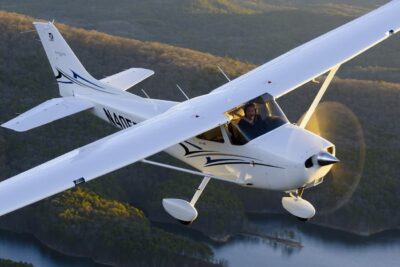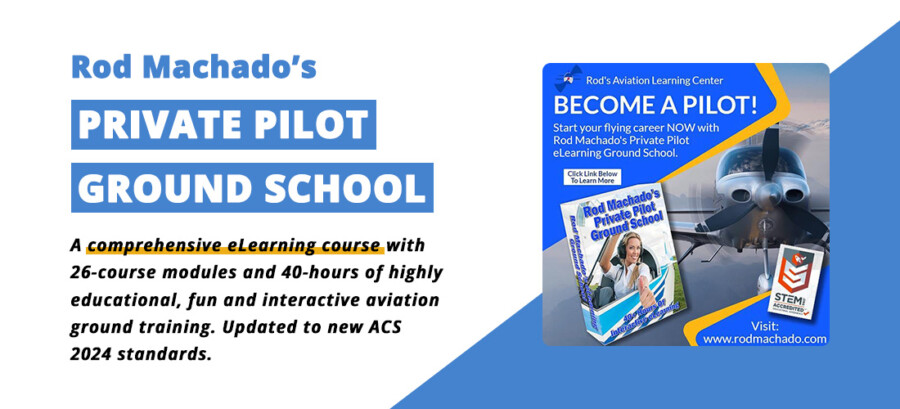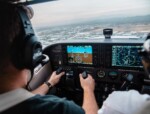Starting Strong in Flight Training – Part 1: Look at Your Finances
23 June 2017 | Updated on February 05, 2024
This post is part of the story series Starting Strong in Flight Training.
In this blog series, flight instructor and Flex Air flight school founder Charles Copeland walks you through some of the issues that come up with flight training. This series in written from an FAA perspective, so depending on where you live the facts and figures may be different.
View all stories in this seriesPart 1 will cover the financial aspect of getting your pilot’s license, in which Charles breaks down the different expenses like fuel, airplane rent, headsets and other aspects.
For those of you that don’t know me, I run a small flight school called Flex Air in Manhattan Kansas. It started out as me and a 172; we have grown to two planes, a flight simulator and three other instructors in just over one year. Just recently I sat down with our staff and tried to identify where we could use some improvement, and it seemed that we were having a high washout rate of students virtually quitting within the first ten hours.


With just over 30 active students and a wait list, I hadn’t really thought very hard on why people were leaving our school. As it’s such a small airport, I knew that they weren’t training with anyone else (we’re the only flight school), but for various reasons we’ve had people wash out of our program, and I’ve identified 5 primary things that can help new students and potential students get a good start in aviation. Disclaimer: I am an aviator, not a writer.
The most common issue in aviation is money. Flight training is extremely expensive. It is the main reason very few people are pilots and attributes to the pilot shortage. It’s also the reason flying privately has such a high status to it–because it truly is expensive. When I meet potential students, I like to be super upfront with all of the costs so they understand. We have many different costs associated with obtaining a private pilot certificate.
Before I get into an explanation of the costs and potentially lose your attention, I tell my students to plan on around $8-9,000. Can it be done cheaper? Yes. I’ll explain a line by line item of how I come up with that number below and then a blank formula for you to play with it. The problem with this is we’d like to do all of your training in 4-6 months. If you don’t have the finances to drop $9k in 6 months, don’t start your training. In the end, the more you drag it out, or don’t show up for long periods of time, you’ll likely have to do most of it over again. Take a hard look at your finances before you start. $100/hour for an airplane doesn’t seem too bad until you have to fly for 40 hours.
Fuel
The blunt of the cost is flight time. Planes are expensive to fuel, maintain, purchase and store. The FAA says in a Part 61 flight school like mine, you need a minimum of 40 flight hours with 20 of those hours being with a flight instructor. Unfortunately, the average of pilots taking the practical is around 50-60 hours. It can be done in less than 50, but the student has to be on their A-game to get it done. I took it at 63 hours. I always tell students to plan on at least 50 hours and 30 hours of an instructor in flight.
So how much does that cost? Well, I have no idea how much it will cost you, but I can tell you what it costs my students. Our aircraft are about $105/hour with fuel (some places might give you a “dry” rate that doesn’t include the fuel). So for 50 hours you’re looking at $5,250. Let’s just pretend you’re going to be a student at my flight school, and I’ll show you how to adapt my math later on to your exact situation. The cost of flying an airplane may not seem that bad alone, but now I need to hire you an instructor to teach you how to fly it. In aviation we call this “dual received”: each hour you are instructed in flight will be logged (minimum of 20) as follows. We charge $40 and hour for “dual given” or as “dual received” from your perspective. Although 20 is the minimum, I bump that up and tell students to expect to pay for at least 30 hours of dual time, or $1,200.


Flight sim
The airplane is an extremely expensive place to learn. Many places like Flex Air have added a flight simulator as a cheaper, safer and easier place to learn certain concepts without having to be in an actual airplane. You can legally log 2.5 hours of an approved simulator towards your 40-hour minimum which makes it even better. As simulator technology improves, I truly believe this will drive down the cost of obtaining a pilot certificate. We charge $25/hour for our Redbird TD2 simulator, but just like the airplane you need an instructor with it. As you’re getting “dual received” we charge $40/hour for the instructor making it $65/hour. We have just bought our simulator, but are expecting students to average roughly 10-20 hours on it for an entire rating- I’m going to figure in ten hours for you at our flight school, or $650.
Ground instruction
There is also a lot to learn about flying that isn’t actually about flying the airplane. Things like how to make a flight plan, how to enter into airspace, what kind of weather you need to fly into and where to find out about it are all things that require additional instruction. Most instructors charge a different ground rate than “dual received/given” rates. We charge $25 an hour and tell you to expect around 20 hours towards your check ride. Our ground is driven towards actual flight and the check ride prep.
We do not teach content for the written examination. We will sit down with you after you’ve taken it and go over the questions you missed, but we don’t teach it as part of our program. Instead, I send you to a cram course provided by Aviation Seminars. No, they aren’t paying me to name drop; I just genuinely think it’s a great program. We just started this new philosophy in January and have had 16 take the course and attempt the written…with a 100% pass rate (a 70% or better). We have a discount code we use for a discount of $355 for the weekend. If there isn’t one in your city, you might need to add in a hotel room into your calculation. The written test itself is a $155 cost, so passing it the first time will prevent you from having to spend even more money. For our math, I’m figuring in that you took the class and passed it the first time. I have faith in you!
A lot of students also supplement their flight training with some sort of ground school. We have a more traditional 8-week class we offer each fall and spring for $200–that’s one night a week for a few hours. You’ll find many flight schools, clubs and universities offer some sort of night class. These classes make you an extremely well-rounded pilot, it’s so tough to teach you every single thing there is to know about being a private pilot, and it gets expensive for us to teach you much over what the FAA sees as the bare minimum. I highly recommend a class like this. If it’s not within your calendar to commit to a class like this, or one isn’t offered in your area, then try an online course. They range from $150 online courses through Sporty’s, King’s and ASA where you watch a bunch of videos, to more expensive in-depth and interactive courses from someone like MzeroA. Do some research before you start a program; don’t just purchase the first one. A lot of them give you some kind of “try before you buy” type thing so you can see if it actually fits your learning style. YouTube is also amazing. I send links to my students all the time from YouTube.


Headset
Another big variable on flight training is buying a headset. I’ve seen cheap ones on amazon that are brand new for $65 (they suck), and I personally fly a LightSpeed Zulu that my loving mother dropped $1,000 on. (Shoutout to Vonda Copeland for being an amazing mom). If you’re going to be flying a lot in non-pressurized aircraft, get a nice headset and protect your hearing. Also get one with a nice mic. You can get a great fitting headset that has a poor quality mic, and it totally ruins the headset. I have four spares that I let cadets use, I have the most basic $250 David Clark (H10-30) for them to see the quality, I have the $300 David Clark H10-20 with the upgraded mic (so worth it between the two), and a Bose A20 to show them what a $1,000 headset feels like. I sometimes let them use my Lightspeed because it has Bluetooth for long cross countries. Beg and borrow to get an experience with a headset and find one you like. There are programs online like Sporty’s and Amazon with a return policy if you make a regrettable mistake, but it’s easiest just to borrow if you can at first. But don’t be a bum forever; eventually, get your own. Plus, it’s kind of gross sharing that mic cover with everyone. I’m figuring in the $300 H10-20 for you.


Medical
You’ll also need to get at least a Class 3 medical. If you are planning on becoming a professional pilot eventually, I suggest getting a Class 1 just to make sure you can even get one. I’ll talk more about getting a medical in my next article- but this is an additional cost. In our area, a Class 3 will cost $150. In some areas they’re super cheap, I paid $75 for my last Class 1 in Wichita but in more rural/local areas like MHK it’s going to be priced as a normal office visit. If you don’t read my other article- a good note is get your medical before you fly. Usually it’s a pretty easy process, but the FAA is known for having a difficult medical approval process if you have any issues, and this can add time and money to this whole math equation that you should identify on the front end and not right before you need it to solo an aircraft.
Checkride
After you’ve spent all of this money on training, and it seems as though the end is in sight, there is also a cost to pay a Designated Examiner for the practical and oral portion of the test. We commonly call this test a “check ride”. The primary DE that I use charges $350 and is nice enough to not charge a retest fee if you have to come back. Others charge the same but usually charge a retest fee of $150 if you don’t do so well the first time. I’ve heard horror stories of having to pay $500-700 just for a check ride in other areas, do your research on this ahead of time. Our DEs are at least an hour flight one way, so although it seems lower than most, the cost of the flight does add into it.
Other
I also try to add in $250 for random items that may come up. You’ll need to buy some maps and stuff for flight planning, you might buy a book that you’ll probably never read, or a t-shirt as well. There are so many things you can spend your money on, but try to be very thoughtful on it. Programs like Garmin Pilot and Foreflight are great, but it has an annual fee- and if you don’t already own the equipment like an iPad you’re going to have to get one. Naturally, if you have money to spend then please spend it on aviation- this is an industry I love and I appreciate people supporting the industry. But if you’re on a budget, buy a used iPad instead of new. Don’t buy the $400 Garmin Pilot watch (for example), and really think about what you need to get through training.
In a previous life, I was an accountant that grew up on a farm in rural Kansas. I still count my pennies and am very cost conscious even for my students. I see students in many parts of the spectrum, ones that spend a ton of money, and others that watch every dollar go out the window. I hope this article gives some more insight to what the costs are and why. Getting your certificate is a significant investment and something that I believe should be well thought out. Unfortunately, the cost is a big barrier to people entering into aviation, and that’s something I cannot help. Just when I do something like add a simulator to help decrease flight time, it seems like something goes up (my MX labor just went up $10/hour in April) so we have to raise costs elsewhere.
My advice
My best advice is to go into training prepared, study while you’re in training and schedule regularly. The more you do this, the less flight time will be used going over things that you’ve already done. Also, don’t be afraid to ask questions. Pilots love to talk, just ask anyone that knows me. The internet has a wealth of free knowledge you can tap into. Just make sure you spend quality time on the things you need to spend it on and not just what you want to.
As always, if there are any questions you have feel free to get in touch with me at charlie@goflexair.com.
This post is part of the story series Starting Strong in Flight Training.
In this blog series, flight instructor and Flex Air flight school founder Charles Copeland walks you through some of the issues that come up with flight training. This series in written from an FAA perspective, so depending on where you live the facts and figures may be different.
View all stories in this series





























